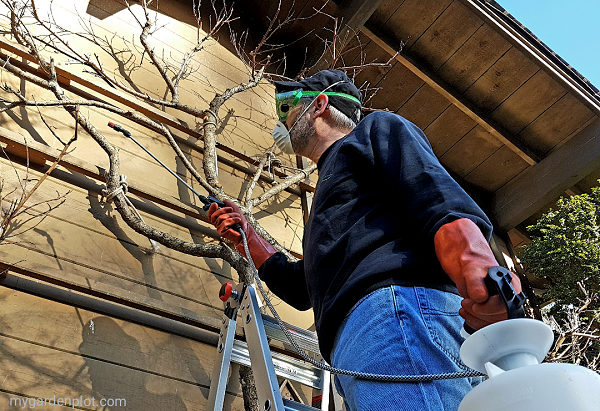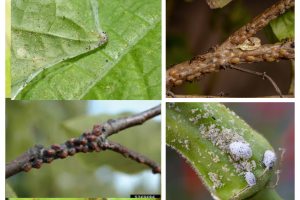Prevent a sticky situation … use dormant oil on fruit trees

Well, Mother Nature must have realized she forgot to change her thermostat to winter except for that one week. But as the weather prognosticators forecasted, we are back up to the mild temps.
And we are already past the halfway mark on this leap year February. But is there anything for a gardener to do except wait for those seeds to come in the mail? Absolutely.
Now is the time, if you grow fruit trees or ornamental trees that get certain problems, to prepare to apply the most effective, dare I say, control that can even be used by certified organic gardeners and producers. What is this magical elixir? Dormant Oil Spray.
Dormant oil doesn’t kill pests and disease by a chemical action; it is physical, strangling. How fun! Most insect treatments are truly chemical controls. Take insecticides: Many are nerve toxins at the insect level. But as I always say, insects are the most successful life form on earth. They procreate so voluminously and quickly that some offspring will have a natural resistance and then when they breed together, you have resistance.
The old saying, “Better living through chemistry,” doesn’t always work. And, unfortunately, that is how we have helped to create superbugs, whether it is insects resistant to almost every pesticide, or for us humans, antibiotic-resistant diseases. Too much of a good thing — isn’t.
Not so with dormant oil, and all-season oil — their strangling action is physical. Hence, no way to build up a resistance. I will dedicate another column to all-season horticultural oil, but now is the time for dormant oil.
Fruit trees have several insect pests and diseases. To get unblemished, unchewed fruit guaranteed, there is a season-long spray schedule provided by the University of Illinois Extension. This chart includes the critical timing of various fungicides, insecticides and other controls.
How much one wants to spray or not is always up to the individual gardener. As for me, my apple pie might just have a little more protein than yours if I don’t find every worm, but that is my decision, and more pie for me.
Dormant oil is a great middle of the road — only one application, and pretty effective control for some fruit tree issues. Dormant oil is also good for some ornamental trees and shrubs that are plagued with scale insects. Magnolia scale has been raging in Will County for the last 5 years.
There are some trees that you should not use dormant oil on, including maple, hickory, redbud, blue spruce, black walnut, beech, Douglas fir and several other evergreens.
You need to know the basics, though. First, dormant oil is called dormant for a reason. It is thick and viscous, and can be used ONLY when plants are totally dormant. If dormant oil is applied to a growing plant, the plant will go dormant—permanently, as in die.
Growing plants’ leaves have openings, stomata, like mouths. If they are covered with dormant oil, they will suffocate. And that includes the tricky times of early bud break when we have had temps that were 12 last week but 50 this week.
When you read the label (and you WILL read the label), there are special instructions about timing of dormant oil. It needs to be applied when the air temperature is going to be above 32 degrees for 24 hours. And with our wacky Midwest weather, that can be a challenge to judge.
Add to that, the recent news that we have moved up a horticultural zone, from Zone 5a to 5b, and now all the way to 6. It is tricky to time dormant oil treatment. While researching the latest and greatest information for this article, I asked our University of Illinois Extension Entomology Specialist: Since we have warmed up, do we need to alter the timing of dormant oil sprays?
The tricky part is we want to apply the dormant oil as late in the season so the pests we are trying to control have come out of their own winter hibernation and are starting to look for their summer digs, but not so late that our plants have also awakened.
She did some investigation herself and said, so far, we are sticking with the current recommendations of applying dormant oil in March for our fruit trees. This timing addresses two issues: As mentioned above, the temperature has to be above 32 degrees for 24 hours. The oil suspension is mixed with water, and if the temperatures dip below freezing, the water separates out and the effectiveness of the application is greatly reduced. And remember, dormant oil application is a one-and-done situation.
The other timing issue, especially this year, is that successful nature of insects that I mentioned. Insects can break dormancy if the temps warm up. I am sure that you have seen the occasional fly or bee already. I know several beekeeper friends have posted pics of their busy, active hives on these warm days.
When it comes to the pest insects, these warm days are the ideal time to smother them with the dormant oil. But the tricky little bugs are great strategists; if the temps dip back into the cold zone, they can go back into dormancy.
One other important thing to check for before using dormant oil, is the beneficial insect cocoons. Some of our most beloved moths, cecropia and other silk moths, overwinter in camouflaged, brown paper bag-looking cocoons. These are large cocoons, so do a quick check before spraying.
Then finally, spraying: You want complete coverage, including upper and under limbs, trunk and some gardeners like to spray the ground around the base of the trees. Remember, you are doing this application only once per year; make every drop count!

Clockwise from upper right: spider mites, scale, mealybugs, and magnolia scale are some of the insects controlled by using dormant oil spray in early March.
